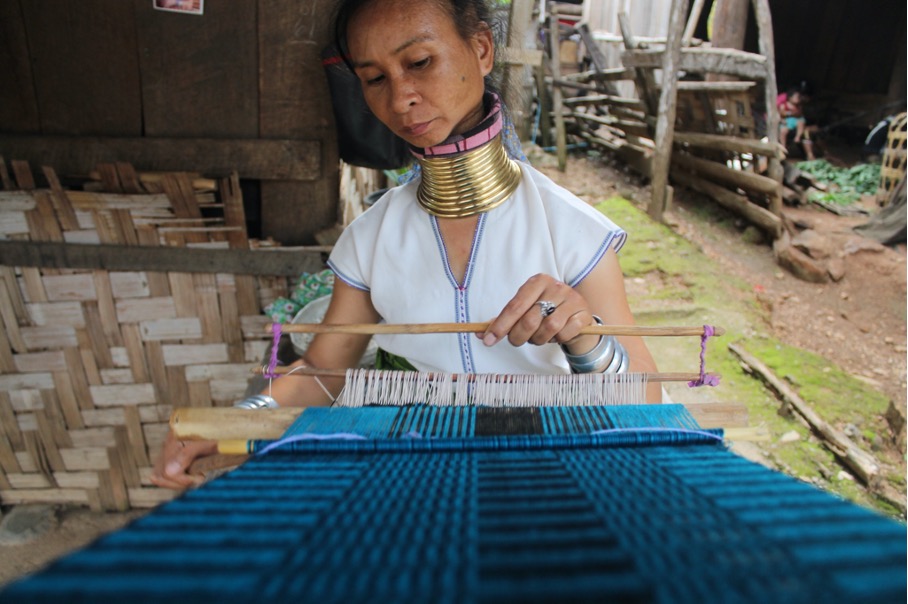|
Huay Pu Keng
Huay Pu Keng is a village located in the province Mae Hong Son, in the northwest of Thailand. The village is inhabited by the Tai Yai, a Thai ethnic community and four subgroups of the Karenni people, namely the Kayan, Kayaw, Red Karen and Pakayor. The Kayan women in particular became famous because tourists began to find interest in their long necks with brass rings. Geography Location Huay Pu Keng is the largest Kayan village located in Mae Hong Son province in northern Thailand, close to the Thai Myanmar border. This village is located in a remote hilly area along the Pai River, surrounded by dense rainforest. You can only reach the village by boat. Climate Northern Thailand is known for its milder weather with colder temperatures. During the months of November to February, the winter is mild and dry. Daytime temperatures are 27 °C -32 °C with plenty of sunshine. Evenings are cooler and temperatures are 9 °C -14 °C. The dry season, from Mar ... [...More Info...] [...Related Items...] OR: [Wikipedia] [Google] [Baidu] |
Mae Hong Son
Mae Hong Son ( th, แม่ฮ่องสอน, ) is a town (''thesaban mueang'') in north-west Thailand, capital of Mae Hong Son Province. It is in the Shan Hills, near the border with Burma along the banks of the River Pai. As of 2018, the town had 7,066 inhabitants. The town covers the ''tambon'' Chong Kham of the Mueang Mae Hong Son district. Mae Hong Son is north of Bangkok and northwest of Chiang Mai. History The territory of Mae Hong Son Province was formerly part of Mawkmai State, one of the Shan States which had been founded in 1767 by Hsai Khiao, hailing from a noble family of Chiang Mai. As a result of the Anglo-Siamese Boundary Commission of 1892-93 Mae Hong Son district was ceded to Siam, but the adjac ... [...More Info...] [...Related Items...] OR: [Wikipedia] [Google] [Baidu] |
Tribe
The term tribe is used in many different contexts to refer to a category of human social group. The predominant worldwide usage of the term in English language, English is in the discipline of anthropology. This definition is contested, in part due to conflicting theoretical understandings of social and kinship structures, and also reflecting the problematic application of this concept to extremely diverse human societies. The concept is often contrasted by anthropologists with other social and kinship groups, being hierarchically larger than a lineage or clan, but smaller than a chiefdom, nation or state (polity), state. These terms are equally disputed. In some cases tribes have legal recognition and some degree of political autonomy from national or federal government, but this legalistic usage of the term may conflict with anthropological definitions. In the United States, Tribe (Native American), Native American tribes are legally considered to have "domestic dependent ... [...More Info...] [...Related Items...] OR: [Wikipedia] [Google] [Baidu] |
Glutinous Rice
Glutinous rice (''Oryza sativa var. glutinosa''; also called sticky rice, sweet rice or waxy rice) is a type of rice grown mainly in Southeast and East Asia, and the northeastern regions of South Asia, which has opaque grains, very low amylose content, and is especially sticky when cooked. It is widely consumed across Asia. It is called glutinous ( la, glūtinōsus) in the sense of being glue-like or sticky, and not in the sense of containing gluten (which it does not). While often called ''sticky rice'', it differs from non-glutinous strains of japonica rice which also become sticky to some degree when cooked. There are numerous cultivars of glutinous rice, which include ''japonica'', ''indica'' and ''tropical japonica'' strains. History In China, glutinous rice has been grown for at least 2,000 years. However, researchers believe that glutinous rice distribution appears to have been culturally influenced and closely associated with the early southward migration and distribu ... [...More Info...] [...Related Items...] OR: [Wikipedia] [Google] [Baidu] |
Lao Cuisine
Lao cuisine or Laotian cuisine ( lo, ອາຫານລາວ) is the national cuisine of Laos. The staple food of the Lao is sticky rice ( lo, ເຂົ້າໜຽວ, khao niao). Laos has the highest sticky rice consumption per-capita in the world with an average of of sticky rice consumed annually per person. Sticky rice is deeply ingrained in the culture, religious tradition and national identity of Laos. It is a common belief within the Lao community that no matter where they are in the world, sticky rice will always be the glue that holds the Lao communities together, connecting them to their culture and to Laos. Affinity for sticky rice is considered the essence of what it means to be Lao. Often the Lao will refer to themselves as ''luk khao niaow'' ( lo, ລູກເຂົ້າໜຽວ), which can be translated as 'children or descendants of sticky rice'. The International Rice Research Institute (IRRI) has described Laos as a “collector’s paradise”. Lao ... [...More Info...] [...Related Items...] OR: [Wikipedia] [Google] [Baidu] |
Burmese Cuisine
Burmese cuisine () encompasses the diverse regional culinary traditions of Myanmar, which have developed through longstanding agricultural practices, centuries of sociopolitical and economic change, and cross-cultural contact and trade with neighboring countries at the confluence of South Asia, Southeast Asia, and East Asia, including the modern-day nations of India, China, and Thailand. Burmese cuisine is typified by a wide-ranging array of dishes, including traditional Burmese curries, Burmese salads, and soups that are traditionally eaten with white rice. Burmese cuisine also features noodles in many forms, as fried or dry noodles, noodle soups, or as noodle salads, as well as Indian breads. Street food culture has also nurtured the profuse variety of traditional Burmese fritters and traditional snacks called '' mont''. The contrasting flavor profile of Burmese cuisine is broadly captured in the phrase ''chin ngan sat'' (ချဉ်ငန်စပ်), which literally me ... [...More Info...] [...Related Items...] OR: [Wikipedia] [Google] [Baidu] |
The Local Kayan Food
''The'' () is a grammatical article in English, denoting persons or things already mentioned, under discussion, implied or otherwise presumed familiar to listeners, readers, or speakers. It is the definite article in English. ''The'' is the most frequently used word in the English language; studies and analyses of texts have found it to account for seven percent of all printed English-language words. It is derived from gendered articles in Old English which combined in Middle English and now has a single form used with pronouns of any gender. The word can be used with both singular and plural nouns, and with a noun that starts with any letter. This is different from many other languages, which have different forms of the definite article for different genders or numbers. Pronunciation In most dialects, "the" is pronounced as (with the voiced dental fricative followed by a schwa) when followed by a consonant sound, and as (homophone of pronoun '' thee'') when followed by a ... [...More Info...] [...Related Items...] OR: [Wikipedia] [Google] [Baidu] |
Cultural Identity
Cultural identity is a part of a person's identity, or their self-conception and self-perception, and is related to nationality, ethnicity, religion, social class, generation, locality or any kind of social group that has its own distinct culture. In this way, cultural identity is both characteristic of the individual but also of the culturally identical group of members sharing the same cultural identity or upbringing. Cultural identity is a fluid process that is changed by different social, cultural, and historical experiences. Some people undergo more cultural identity changes as opposed to others, those who change less often have a clear cultural identity. This means that they have a dynamic yet stable integration of their culture. There are three pieces that make up a persons cultural identity, these are cultural knowledge, category label, and social connections. Cultural knowledge is when a person connects to their identity through understanding their culture's core charact ... [...More Info...] [...Related Items...] OR: [Wikipedia] [Google] [Baidu] |
Sensationalism
In journalism and mass media, sensationalism is a type of editorial tactic. Events and topics in news stories are selected and worded to excite the greatest number of readers and viewers. This style of news reporting encourages biased or emotionally loaded impressions of events rather than neutrality, and may cause a manipulation to the truth of a story. Sensationalism may rely on reports about generally insignificant matters and portray them as a major influence on society, or biased presentations of newsworthy topics, in a trivial, or tabloid manner, contrary to general assumptions of professional journalistic standards. Some tactics include being deliberately obtuse, appealing to emotions,"Sensationalism." [...More Info...] [...Related Items...] OR: [Wikipedia] [Google] [Baidu] |
Neck Ring
Neck rings, or neck-rings, are any form of stiff jewellery worn as an ornament around the neck of an individual, as opposed to a loose necklace. Many cultures and periods have made neck rings, with both males and females wearing them at various times. Of the two most notable types, one is the torc, an often heavy and valuable ornament normally open at the throat. These were worn by various early cultures but are especially associated with the ancient Celts of the European Iron Age, where they were evidently a key indicator of wealth and status, mostly worn by men. The other type is one or more spiral metal coils of many turns, often worn only by married women. Illusion of elongation In a few African and Asian cultures, neck rings are worn usually to create the appearance that the neck has been stretched. The custom of wearing neck rings is related to an ideal of beauty: an elongated neck. Neck rings push the clavicle and ribs down. [...More Info...] [...Related Items...] OR: [Wikipedia] [Google] [Baidu] |
Tourism
Tourism is travel for pleasure or business; also the theory and practice of touring (other), touring, the business of attracting, accommodating, and entertaining tourists, and the business of operating tour (other), tours. The World Tourism Organization defines tourism more generally, in terms which go "beyond the common perception of tourism as being limited to holiday activity only", as people "travelling to and staying in places outside their usual environment for not more than one consecutive year for leisure and not less than 24 hours, business and other purposes". Tourism can be Domestic tourism, domestic (within the traveller's own country) or International tourism, international, and international tourism has both incoming and outgoing implications on a country's balance of payments. Tourism numbers declined as a result of a strong economic slowdown (the late-2000s recession) between the second half of 2008 and the end of 2009, and in consequence of t ... [...More Info...] [...Related Items...] OR: [Wikipedia] [Google] [Baidu] |
Stereotypical
In social psychology, a stereotype is a generalized belief about a particular category of people. It is an expectation that people might have about every person of a particular group. The type of expectation can vary; it can be, for example, an expectation about the group's personality, preferences, appearance or ability. Stereotypes are sometimes overgeneralized, inaccurate, and resistant to new information, but can sometimes be accurate. While such generalizations about groups of people may be useful when making quick decisions, they may be erroneous when applied to particular individuals and are among the reasons for prejudicial attitudes. Explicit stereotypes An explicit stereotype refers to stereotypes that one is aware that one holds, and is aware that one is using to judge people. If person ''A ''is making judgments about a ''particular'' person ''B'' from a group ''G'', and person ''A'' has an explicit stereotype for group ''G'', their decision bias can be partiall ... [...More Info...] [...Related Items...] OR: [Wikipedia] [Google] [Baidu] |


.jpg)

.png)




